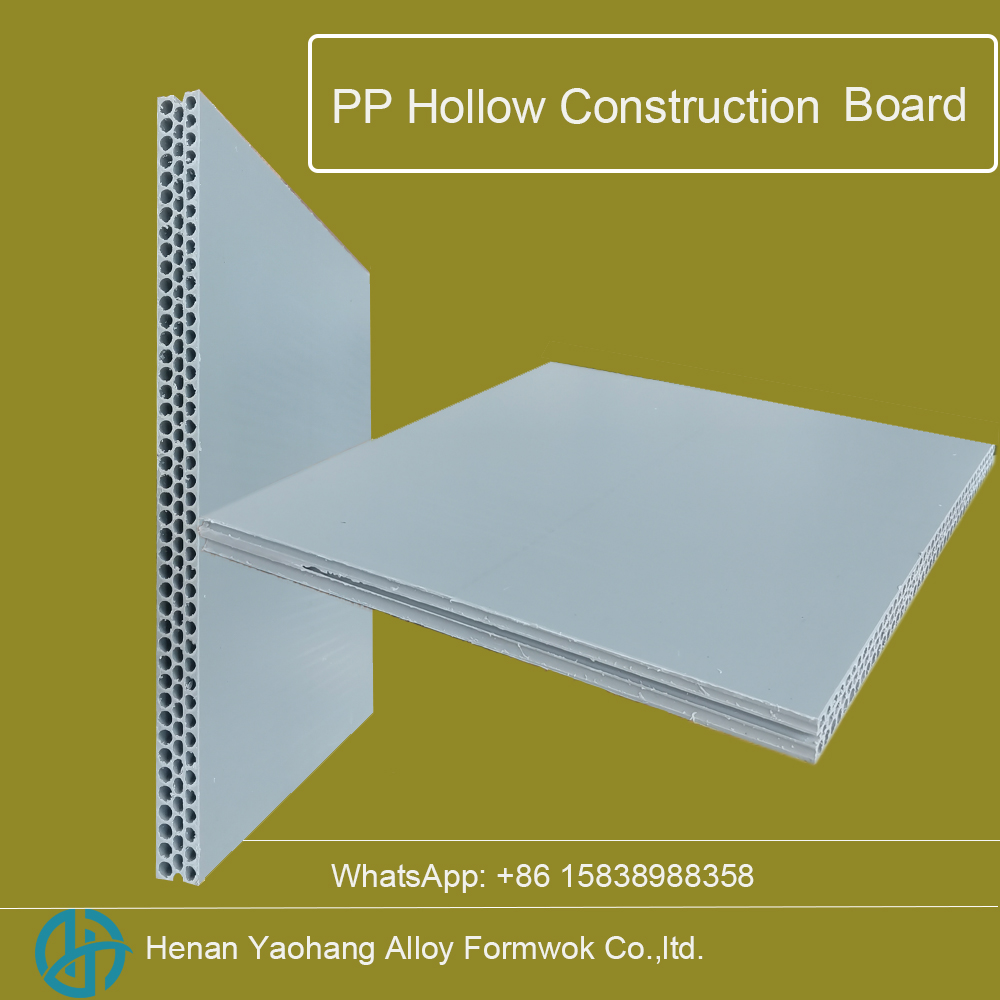Plastic Formwork
This article mainly refers to PP hollow plastic formwork.
We call it PP hollow plastic formwork because hole structures are evenly distributed in the middle of our plastic formwork. Its name is easy to distinguish from other formwork such as PVC foam plastic formwork and ABS engineering plastic formwork. Why do we use polypropylene as the material to produce plastic formwork? The main reason is that PP material can meet better ductility and structure rigidity after professionally modified granulation. Thus, it suits building formwork and avoids the shortcomings of PVC foam templates such as brittleness, and short service life. It also has gradually gained favor in the market for its high turnover times.

Main Characteristics
1. It has the features of high strength, impact resistance, anti-abrasion, and times of turnover reach more than 50 times. 80 times use are available if maintained well.
2. It has good machinability, can be sawed, planed, nailed, and can be used simultaneously with wood formwork.
3. The surface of the concrete structure formed is smooth and can reach the requirements of facing and decorative water without secondary plastering. It saves materials and time, reduces cleaning and maintenance costs, and the quality of concrete after molding is stable and saves the construction period. It is especially suitable for use in humid environments such as basement projects, bridges, and piers of highways and railways.

4. The hollow plastic building formwork has the advantages of lightweight, low labor intensity of handling operation, high construction efficiency, safety and reliability, no moisture absorption, corrosion resistance, acid and alkali resistance, smooth surface and no need to brush the release agent. Besides, it is convenient for assembly and disassembly.
5. The hollow plastic building formwork is green and environmentally friendly in production. It does not produce waste water and waste gas. It will not cause environmental pollution to the location and surrounding areas.
6. The cost of comprehensive use of the new hollow plastic building formwork can be greatly reduced compared with the traditional wood formwork.
Market recognition
Recently, hollow plastic formwork is becoming more and more popular. More central government-owned enterprises including CSCEC, CREC, and MCC, and private enterprises such as Biguiyuan in China are increasing the use of hollow plastic formwork. Because of its characteristics of fair faced concrete wall, it is often promoted as the first choice for high-quality and benchmark projects.
How to judge the quality?
Sample testing. We can use more times if products can withstand a greater degree of bending, full resilience, and sufficient toughness. What’s more, it doesn’t produce wave patterns to ensure a smooth wall surface if the plates can withstand greater pressure and have small deformation.
Besides, you can also use the following methods.
1. Use a hammer with a small round head to hit the smooth surface of the plastic building formwork and observe the dents on the surface of the building formwork. Good-quality building formwork will have dents but no cracks. This experiment is obvious;
2. The nail-holding strength test is also a judgment. A key factor in the quality of plastic building formwork is to drive a nail 5mm away from the edge of the board to see if there are no cracks, which means the quality of the board is still very good.
Construction technology tips and operating specifications
1. Hollow plastic boards are not cracked or delaminated. They are waterproof and can be used in humid environments.
2. It is easy for workers to nail, drill, saw, and cut. An 80-grit alloy saw blade is recommended when cutting.
3. The surface of the hollow plastic building template is smooth and there is no need to use a release agent before installation.
3. When using the hollow plastic formwork, the direction of the internal vertical ribs should be crosswise with the direction of the supporting keel (wooden square). If the wood is vertical, place the plastic formwork horizontally.
4. When casting in-situ slabs, the spacing between wooden squares is 20~25cm, the spacing between wooden squares for column moldings is 10-15cm, and the spacing between wooden squares for shear walls is ≤15cm.
5. When driving nails, the nail caps should be 5 to 20 mm away from the edge of the formwork to prevent the nail caps from being embedded in the formwork. When driving nails, use moderate force. The length of the nails is generally 30 to 50 mm, and should not be too long or too short.

